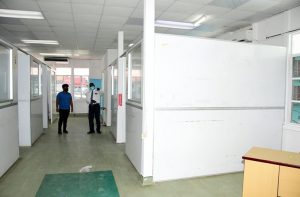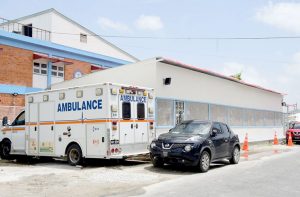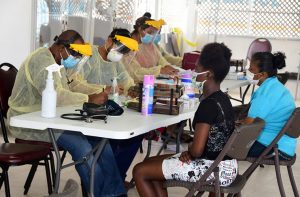–GPHC’s ‘incredible transformation’ to combat COVID-19
A POPULAR saying among Guyanese over the years whenever they happen to fall ill has always been, “I ain’t going Public.”

Thankfully, that time-worn mantra’s about to change, as the bane of their existence at reference, the Georgetown Public Hospital Corporation (GPHC), has defied all the odds thrown its way and utilised its limited resources to create an institution fit enough to fight the deadly Novel Coronavirus (COVID-19).
Medical institutions the world over, through doctors, nurses and other healthcare workers, have been leading the fight against this “invisible killer” known as COVID-19, ever since it reared its ugly head in Wuhan, capital of Central China’s Hubel Province, back in December 2019.
Here in Guyana, this disease has wreaked havoc in the lives of over 113 persons, causing the death of ten to date. And the one thought on everyone’s mind ever since has been, “Ah wonder who next,” as the number of the afflicted continues its inexorable climb with each passing day.
And, with no existing treatment or vaccine for this deadly disease, medical institutions have been forced to be innovative in their approach to fighting it, while also catering for the needs of persons who suffer from preexisting ailments or other injuries.
This is where the GPHC comes in, as it has been leading the way by putting systems in place to ensure that its facilities are properly separated, so that transmission of the disease would not occur. This process started way back in December 2019, when the alarm bells were first sounded in China, so when the scourge did hit Guyana in March this year, GPHC was prepared to lead the fight against it.

The first to concede that doing so was no easy task was GPHC Director of Medical and Professional Services, Dr. Fawcett Jeffery. “There were difficulties, resource difficulties, but we managed to get ventilators, and we established the unit… Since then, we have been moving forward,” he told the Guyana Chronicle during an exclusive interview recently.
As things now stand, the institution is the only facility that has been treating COVID-19 patients, who experience severe forms of the disease, meaning that the hospital has a special Intensive Care Unit (ICU), called the COVID-19 ICU.
FIRST OF ITS KIND
The COVID-19 ICU was one of the first facilities to be established, and it has already treated more than 25 persons.
“We have advanced from there; we have developed systems from the gate to the wards,” Dr. Jeffery said, adding: “Screening is being done at every entrance, and we have set up triage points. We used to have a physical tent for triaging, but we have since constructed a building, so we have a special complex to house doctors from the COVID-19 unit.”
The new complex houses the general medical unit for COVID-19 patients, and the Pediatric COVID-19 Unit, a unit established specifically to treat children.
In walking the Guyana Chronicle through the process of how persons end up in the unit, Dr. Jeffery said every patient and staff of the hospital is screened at the gate before entering the compound, and once they exhibit or have signs or symptoms of the disease, they are sent to the triage point for further screening.
At the triage point, which is a facility established just outside of the hospital’s East Street entrance, persons are x-rayed and swabbed, once it is clear that their condition could be COVID-19. The swabbing is done in an ambulance, right next to the facility. The ambulance was equipped with air conditioning (AC) and other amenities, so that persons can be tested in comfort.
“They go into the ambulance, which has become the procedure room, and after it is done and the sample is sent for testing, persons would go to the well-equipped isolation areas in either the male/surgical ward or the female/medical ward,” Dr. Jeffery said, adding: “Not so long ago, we used to have a tent hospital for persons who are awaiting their results, but it was not the most comfortable place to have people.”
WELL PREPARED
The isolation areas were not only established for comfort, but were also created in anticipation of a surge in COVID-19 cases.
In explaining what he meant by this, Dr. Jeffery said: “We have prepared the hospital so that all patients, non-COVID-19 or else, would be moved to one section; we left the modern section of the in-patient building vacant and ready, so we basically created a barrier between the sections of the hospital.”

This way, he explained, the hospital would not be caught by surprise if there were to be a spike in the cases of the disease.
In essence, the hospital has not only created a generalised separation of care, but has also managed to set up a COVID-19 Dialysis Unit for patients who may experience renal failure. One patient has already been successfully dialysed in the facility, and has since recovered and is at home.
Dr. Jeffery said the hospital has also established a special operating theatre for COVID-19 patients who may require surgery, which facility has also been successfully utilised.
A special COVID-19 maternity unit is also being established to cater for pregnant women who are COVID-19-positive.
“We are setting up an isolation area for the maternity cases; we have always been planning on making that section ready. It is almost ready. The only thing we have to construct is the decontamination area,” Dr. Jeffrey said.
A Neonatal Intensive Care Unit (N-ICU) was also established for babies who may have contracted the disease. To date, however, there is no evidence to show that there is vertical transmission (mother-to-child transmission) of the disease, but as is the old saying, “prevention is better than cure”.
These facilities were established because persons with underlying conditions, the elderly and pregnant women are all in the high-risk population for COVID-19.
“So, we are ready for surgeries, children, general adult population, maternity, and we are working on many more things to ensure that there is proper treatment for COVID-19,” Dr. Jeffery said.
JUSTIFIABLY PROUD
The director was proud, and justifiably so, to say that the hospital has moved forward, but they are hoping that COVID-19 does not stick around for a long time.
So far, the hospital has not seen a “spike” in cases, but there has been a gradual increase in the amount of COVID-19 admissions.
“We are seeing a trend, but it is a slight gradient going upwards; patients are increasing, but gradually… Usually, when you see this kind of increase, you worry, because we have to worry about the epidemic becoming endemic,” Dr. Jeffrey said, adding:
“Endemic in the sense that we will have to live with it until we have a vaccine. We hope Guyana does not go down that road, but we are ready to fight the battle.”
GPHC has been sharing its rules, protocols and plans with other medical institutions here, so that there could be efficiency across-the-board.




.jpg)










